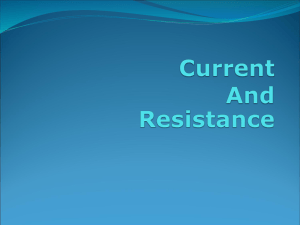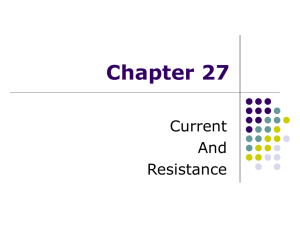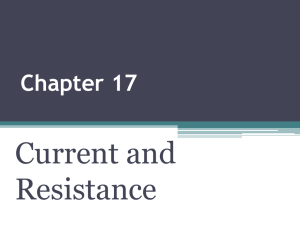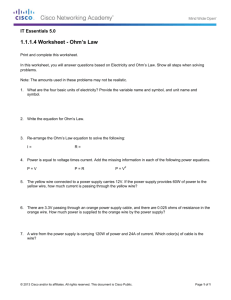Resistance and Resistors
advertisement
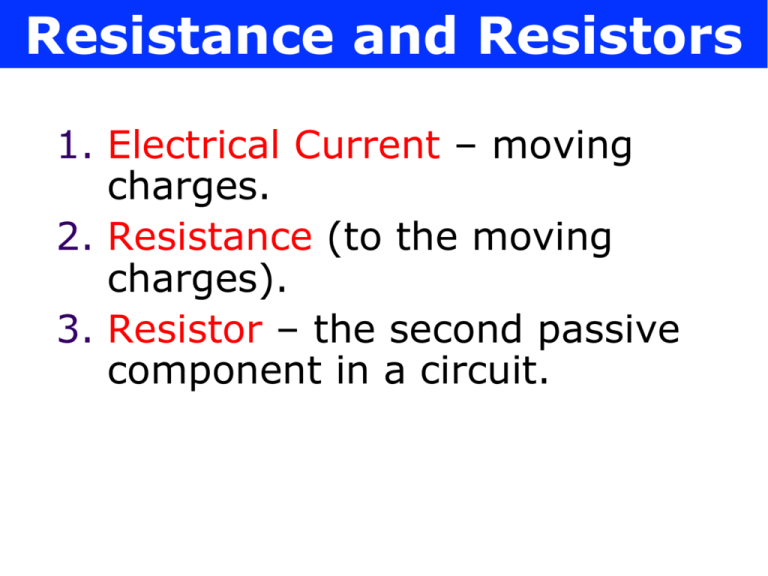
Resistance and Resistors 1. Electrical Current – moving charges. 2. Resistance (to the moving charges). 3. Resistor – the second passive component in a circuit. Capacitance and capacitors The relationship among charge, potential and the capability the object holds charge (capacitance) is Q C≡ ΔV A For a parallel plate capacitor, the capacitance is C = ε 0 d When capacitors connected in parallel: C = C1 + C2 + C3 + ... 1 1 1 1 And in series: = + + + ... C C1 C2 C3 Q2 1 2 Energy stored in a capacitor: U = = C ( ΔV ) 2C 2 Now adding dielectric: C = κ ⋅ CVACUUM Electric Current, the definition l l Assume charges are moving perpendicularly through a surface of area A If ΔQ is the amount of charge that passes through A in time Δt, then the average current is I avg ΔQ = Δt or dQ I= dt + + + A + + + I Electric Current, definition and unit l l Electric current is the rate of charges flowing through some region in space. Already we need a concept of current density in space, but we will leave that to a later discussion. The SI unit of current is ampere (A) l l l l 1A=1C/s The unit ampere is a base unit. The unit for time, second, is also a base unit. What are the base units in the SI system? The unit for charge is then defined as 1C=1A*1s. The unit for charge, coulomb, is not a base unit in SI. The symbol for electric current is I (not as “i” in iApple) SI base units and prefix Direction of Current l l l l The charges that pass through the area could be positive or negative or both. This area may or may not be an actual physical surface. Charges can flow in a conductor or in vacuum (give examples). It is conventional to assign to the current direction as the direction of the flow of positive charges The direction of current flow is opposite the direction of the flow of electrons, which are the charge carriers in a current in most cases. It is common to refer to any moving charge as a charge carrier, positive or negative. Where one has both? Current in a conductor and the drift speed of the carrier l Charged particles move through a conductor under the drive of an electric field inside. Wait! There should be no electric field inside a conductor. Explanation please! l l E A conducting wire can be viewed as an electric field guide. Assume a cross-sectional area A that is perpendicular to and the number of charge carriers per unit volume n. Then nAΔx is the total number of charge carriers in that volume. ! Δx = vd Δt Current linearly proportional to drift speed l The total charge is the number of carriers times the charge per carrier, q l l The drift speed, vd, is the speed at which the carriers move l l l l ΔQ = (nAΔx)q vd = Δx / Δt and Δx = vd Δt Rewrite: ΔQ = (nAvd Δt)q Finally, current, Iave = ΔQ/Δt = nqvdA This is to say that current is linearly proportional to the drift speed vd A typical value of the drift speed l l l l Assume a copper wire, with one free electron per atom contributing to the current The drift speed for a 12-gauge copper wire carrying a current of 10.0 A is 2.23 x 10-4 m/s This is very slow, how come when a switch is closed, the light comes on from a light bulb ~ 10m away? It should have taken ~10/ 2.23 x 10-4 sec which is about 12 hours. What is wrong in the above reasoning? Motion of the electrons, in a conductor l l l l l The actual charge carriers in conductors are electrons The zigzag black lines represents the motion of a charge carrier in a conductor l The net drift speed is small The sharp changes in direction are due to collisions The net motion of electrons is opposite the direction of the electric field The current direction is conventionally defined to be the positive carrier motion direction, or the electric field direction. Motion of the electrons, in a conductor l l l The electric field exerts forces on the electrons in the wire at the same time (almost). These forces cause the electrons to move in the wire and create a current. So the current starts to flow anywhere in the circuit when the switch is closed. In the presence of an electric field, like the one set up by a battery, in spite of all the collisions, the charge carriers slowly move along the conductor with a drift ! velocity, vd The battery does not only supply the electrons, it also (mainly) establishes the electric field Current Density J, the definition The current density J of the current I in a conductor is defined as the current per unit area: I ave = ΔQ Δt = nqvd A ! ! dI I ave J≡ ≅ = nqvd , or J = nqvd dA A Current density is a vector and is in the direction of the positive charge carriers J has an SI unit of A/m2 The relationship to the current is I= ∫ ! ! J ⋅ dA Conductivity and resistivity l l A current density and an electric field are established in a conductor whenever a potential difference is maintained across the conductor For some materials, the current density is directly proportional to the field, that is ! ! J =σE l l The constant of proportionality, σ, is the conductor’s conductivity Another often used parameter is the resistivity, ρ, is just the inverse of the conductivity: ρ ≡ 1/σ And this formula, ! ! J =σE , is called Ohm’s Law. Ohm’s Law l Ohm’s law states that the ratio of the current density to the electric field is a constant σ l l l Mathematically, J = σ E Most metals obey Ohm’s law Materials that obey Ohm’s law are said to be ohmic But l Not all materials follow Ohm’s law l Materials that do not obey Ohm’s law are said to be nonohmic l Ohm’s law is an empirical relationship valid only for certain materials, not a fundamental law of nature Resistance and a more popular form of the Ohm’s Law l From Ohm’s Law: J = σ E ! 1 E One has: E = J = ρ J σ Now exam the section of a wire with length l and cross section A, one has: 1 I l ΔV = El = Jl = ρ Jl = ρ l = ρ I σ A A Now we define a new parameter, the resistance of this section of the wire, R, to be: l R≡ρ A Ohm’s Law becomes ΔV ΔV = RI or R ≡ I Resistance l In SI the unit for resistance is ohm (Ω) l l l l l l 1Ω=1V/A The SI unit of resistivity is Ω·m Resistance is proportional to the resistivity, a constant of the material, the length of the conductor (wire), and inversely proportional to the cross section of the wire. l R≡ρ A Resistivity changes linearly with ρ = ρ0 "1+ α T − T0 $ # % temperature. In a conductor, the voltage applied across the ends of the conductor is ΔV = RI proportional to the current through the conductor ΔV The constant of proportionality is R≡ called the resistance of the I conductor ( ) Resistivity Values and the temperature coefficient α Resistance and Resistors All (almost) materials have resistance Those that are called ohmic if Ohm’s Law R ≡ holds. In a circuit, the resistance of connecting wires (PCB copper traces) are often neglected. A device made to have certain resistance value is call a resistor. ΔV I Ohmic or Nonohmic l Ohmic: l l l The resistance is constant over a wide range of voltages The relationship between current and voltage is linear The slope is related to the resistance l Nonohmic: l l resistance changes with voltage or current The current-voltage relationship is nonlinear Resistance and Temperature l Over a limited temperature range, the resistivity of a conductor varies linearly with the temperature ρ = ρ0 "#1+ α (T − T0 )$% l l ρ0 is the resistivity at some reference temperature To o l To is usually taken to be 20 C l α is the temperature coefficient of resistivity With a resistor: R = R0 "#1+ α T − T0 $% ( l ) This is often used to measure temperature with materials that have large α Electrical Power: work done by electric field l As a charge Q moves from a to b, the electric potential energy of the system increases by QΔV This energy comes from the chemical energy in the battery l l As the charge moves through the resistor (c to d), the system loses this electric potential energy, turning it to heat by the resistor The electric power (energy time rate) the resistor consumes is p= Q Q energy QΔV dQ = = IΔV, as I ≡ time Δt dt ΔV ) ( 2 only with Ohm's Law, p = I R = R 2 Example: Electric Power Transmission The question: Dallas needs 100 MW electric power which is generated 100 miles away. The transmission line (aluminum) has a diameter of 2 inches. How much power must be generated to deliver 100 MW to Dallas, (a) If 110 V is used? (b) if 600,000 V is used? Step 1: pproduced = pdelivered + pon transmission lines pdelivered = I ⋅ ΔV, pon transmission lines = I 2 ⋅ Rline l Step 2: Rline = ρ A = 2.82 ×10 −8 = 4.45Ω l l 2 ×100 ×10 3 ×1.6 3.14 × (1× 25.4 ×10 −3 2 ) Ω Real power lines have resistance Power companies transmit electricity at high voltages and low currents to minimize power losses Example: Electric Power Transmission p 100 ×10 6 = A = 9.1×10 5 A Step 3: (a) ΔV = 110 V → I needed for 100 MW = ΔV 110 pon transmission lines = I ⋅ Rline = ( 9.1×10 2 5 2 ) ⋅ 4.45 W = 3.7 ×1012 W transmission efficiency = pdelivered pproduced ≈ 10 −5 ≈ 0 p 100 ×10 6 2 (b) ΔV = 600, 000 V → I needed for 100 MW = = A = 1.7 ×10 A 5 ΔV 6 ×10 pon transmission lines = I ⋅ Rline = (1.7 ×10 2 2 2 ) ⋅ 4.45 W = 1.2 ×10 5 W transmission efficiency = pdelivered pproduced = 99.9% Example: two incandescent light bulbs In the US, the standard in our grid power system is 110 V. When two incandescent light bulbs (a pure resistive device, with light output proportional to the power consumed), with power specifications of 60 W and 100 W, are connected in parallel, which one is brighter? b1 b2 110V 60W 100W Both bulbs receive the nominal voltage of 110V. They shine as their spec: 60W and 100W. So the 100W bulb is brighter than the 60W. Example: two incandescent light bulbs Now connect them in series, which one is brighter in this case? b1 60W 110V b2 100W Now the voltage 110V is shared by the two bulbs. The current is the same through them. ΔVno2 min al ΔV 2 From p = One has R = pno min al R 2 p = I R Then from ΔVno2 min al pb1 Rb1 5 60 W One has = = = 2 pb 2 Rb 2 ΔVno min al 3 100W So bulb b1, with 60W nominal power consumption, is brighter. Reading material and Homework assignment Please watch this video (about 50 minutes each): http://videolectures.net/mit802s02_lewin_lec09/ Please check wileyplus webpage for homework assignment.

